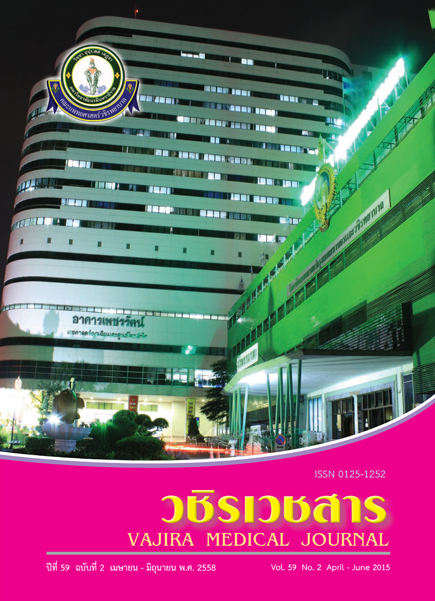Incidence and Detection of the Second Mesiobuccal Canal in the Mesiobuccal Root of Permanent Maxillary Molar Teeth: By Naked Eyes and Magnifying Loupes
Main Article Content
Abstract
Objectives: To determine the incidence of the second mesiobuccal canal (MB 2 canal) in maxillary molars and to compare the efficiency in MB 2 canal detection between two methods: naked eyes with endodontic explorer and dental loupes (x 2.5) with ultrasonics.
Methods: A retrospective cohort study was performed by collecting 104 extracted maxillary molar teeth from patients at Dental Department, Faculty of Medicine Vajira Hospital, Navamindradhiraj University. The floor of the pulp chamber was explored in order to locate the MB 2 canal in 2 stages: Stage 1 was located with naked eyes and endodontic explorer.
Stage 2 was performed in the teeth in which MB 2 canal was not located in stage 1. Stage 2 was located under magnification with x2.5 magnifying dental loupes and ultrasonic tips. All specimens were investigated further by horizontal section to verify the absence or presence of MB 2 canal. The mesiobuccal roots were sectioned horizontally at the level of half-length
of the root, stained with methylene blue dye and observed by magnifying glass (x3). The data was analyzed by percentage, frequency and chi-squared test at the confidence level of 0.05
Results: The incidence of a second canal in the mesiobuccal root of the permanent maxillary first molar was 89% and of the second molar was 86%. The incidence of MB 2 canals between the first and second molars was not different (p=0.66). The use of x 2.5 magnifying dental loupes could increase the number of second mesiobuccal canals located in both permanent maxillary first and second molars compared with naked eyes. (p<0.001).
Conclusion: This study demonstrated a high incidence of MB 2 canals in permanent maxillary molars. It is very important to consider the possible presence of a second mesiobuccal canal in the mesiobuccal root of permanent maxillary molars. This study showed that the use of dental loupes with ultrasonics enhanced the ability to detect the MB 2 canal.


